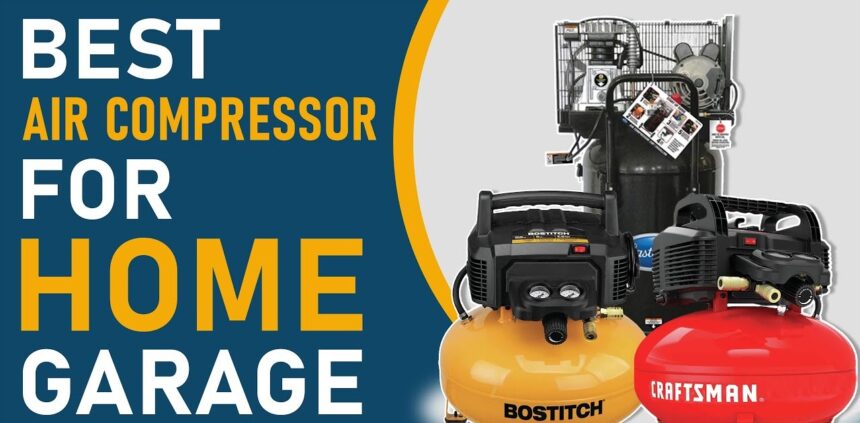Having an air compressor at home can be a game-changer for many tasks. Whether you’re inflating tyres, powering tools, or taking on DIY projects, an air compressor can make life much easier. But what exactly should you know before getting one? Let’s dive into the details.
Types of Air Compressors
When choosing an air compressor, you’ll encounter different types, each with its pros and cons.
Portable vs. Stationary
- Portable Compressors: Ideal for light tasks, these are easy to move around. Perfect for quick jobs like inflating tyres or powering small tools.
- Stationary Compressors: Larger and more powerful, these are fixed in one place and can handle heavier tasks. Best for a workshop or garage setup.
Electric vs. Petrol
- Electric Compressors: Quieter and more convenient for indoor use, these require access to an electrical outlet.
- Petrol Compressors: More powerful and suitable for outdoor use or areas without electricity, but they are noisier and require more maintenance.
Key Features to Look For
When selecting an air compressor, consider these key features:
Power and Performance
The compressor’s power is measured in horsepower (HP) and its performance in cubic feet per minute (CFM). Higher HP and CFM mean the compressor can handle more demanding tasks.
Tank Size
The tank size determines how long you can run the compressor before it needs to refill. For light tasks, a smaller tank (up to 6 gallons) is sufficient. For heavier tasks, consider a larger tank (20 gallons or more).
Portability and Weight
If you need to move the compressor frequently, look for a portable model with wheels and a manageable weight.
Noise Level
Compressors can be loud, so check the decibel (dB) rating. Lower dB means quieter operation.
Accessories and Attachments
Ensure the compressor comes with or can use essential accessories like hoses, connectors, and tool attachments.
More Read: 1960s Concrete Roof Tiles: A Journey Through Time
Typical Home Uses for an Air Compressor
An air compressor can tackle a variety of tasks, making it a versatile tool in any home.
Inflating tyres
Quickly inflate car, bicycle, and motorbike tyres to the correct pressure, saving you trips to the petrol station.
Powering Tools
Use air-powered tools such as nail guns, staplers, spray guns, and impact wrenches for various DIY and repair projects.
Cleaning and Dusting
Blow dust and debris from workspaces, tools, and hard-to-reach areas.
Painting and Spraying
Achieve a smooth finish with paint sprayers for furniture, walls, or vehicles.
DIY Projects
Assist in woodworking, metalworking, and other home improvement projects.
Choosing the Right Air Compressor
To find the perfect air compressor for your needs, follow these steps:
Assessing Your Needs
Consider what tasks you’ll use the compressor for. Light tasks require less power and a smaller tank, while heavy tasks need more robust specifications.
Matching Features to Tasks
Ensure the compressor’s features align with the tasks you have in mind. For example, high CFM for painting and larger tanks for continuous use.
Budget Considerations
Balance your budget with your needs. While it’s tempting to go for the cheapest option, investing in a reliable compressor can save money in the long run.
Setting Up Your Air Compressor
Proper setup is crucial for safe and efficient use.
Safety Precautions
Read the user manual and follow all safety guidelines. Put on the proper safety equipment, such as goggles and earplugs.
Space Requirements
Ensure you have enough space for the compressor, including clearance for ventilation and access for maintenance.
Proper Ventilation
If using a petrol compressor, ensure proper ventilation to avoid dangerous fumes. Even electric compressors need good airflow to prevent overheating.
Maintenance and Care
Frequent maintenance prolongs the life of your compressor and keeps it operating properly.
Regular Inspections
Check for wear and tear, leaks, and other issues regularly.
Cleaning and Replacing Filters
Keep the air filters clean and replace them as needed to ensure optimal performance.
Checking for Leaks
Inspect hoses and connections for leaks and fix them promptly to maintain pressure and efficiency.
Storing the Compressor
Store your compressor in a dry, cool place to prevent rust and other damage.
Safety Tips
Using an air compressor involves handling high pressure, so safety is paramount.
Using Safety Gear
Always wear safety gear like goggles, gloves, and ear protection.
Handling Pressure and Hoses
Avoid kinking hoses and release pressure before disconnecting them. Handle hoses carefully to prevent accidents.
Avoiding Common Mistakes
Don’t exceed the compressor’s pressure limits, and always follow the manufacturer’s guidelines.
Air Compressor Accessories
To maximise your compressor’s utility, invest in essential accessories.
Essential Tools and Attachments
Consider getting hoses of various lengths, connectors, blowguns, and tool attachments to expand your compressor’s capabilities.
Tips for Maximising Efficiency
Use the right tools for each task and ensure all connections are secure to prevent air loss.
DIY Projects with an Air Compressor
An air compressor can be a valuable asset for various DIY projects.
Simple Home Repairs
Quickly tackle home repairs like fixing leaks, inflating tyres, or cleaning surfaces.
Furniture Restoration
Use air tools to sand, paint, and finish furniture pieces efficiently.
Crafting and Hobbies
Power your crafting tools for projects involving wood, metal, or other materials.
Troubleshooting Common Issues
Having troubleshooting skills can help you avoid wasting time and frustration.
Compressor Won’t Start
Check the power source, ensure the switch is on, and inspect for blown fuses or tripped breakers.
Low-Pressure Problems
Ensure the tank is full, check for leaks, and clean or replace filters.
Unusual Noises
Inspect for loose parts, worn-out components, or blockages that might cause noise.
Advantages of Owning an Air Compressor
Owning an air compressor offers numerous benefits.
Cost Savings
Save money by doing tasks at home instead of hiring professionals or renting tools.
Convenience
Have a powerful tool ready for a variety of tasks whenever you need it.
Versatility
Use one tool for numerous applications, from inflating tyres to painting furniture.
Disadvantages to Consider
While beneficial, air compressors have some drawbacks.
Initial Cost
The upfront cost can be high, especially for larger or more powerful models.
Maintenance Requirements
Regular maintenance is necessary to keep the compressor in good working condition.
Noise Concerns
Even the quietest models can be noisy, which might be an issue in certain settings.
More Read: 3D Stone Wall Panels: Transforming Your Space with Elegance and Style
Conclusion
An air compressor is a versatile and valuable tool for any home, offering convenience, cost savings, and a wide range of applications. By choosing the right model, setting it up properly, and maintaining it well, you can enjoy the benefits of having an air compressor for years to come.
FAQs
How often should I maintain my air compressor?
Regular maintenance is crucial. Check the user manual, but generally, inspect your compressor before each use and perform thorough maintenance every few months.



